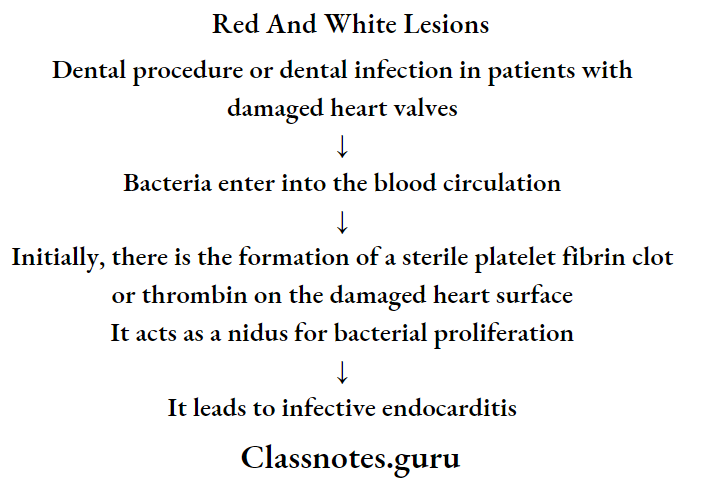Oral Medicine Specific Systemic Disorder Important Notes
1. Multinucleated Giant Cells Are Seen In
- Cherubism
- Hyperparathyroidism ‘
- Aneurysmal bone cyst
- Giant cell granuloma
- Osteoclastoma
- Osteosarcoma
- Herpes
- Leprosy
- Eosinophilic granuloma
2. Specific Systemic Russell’s Bodies
- They are immature plasma cells
- Seen in
- Chronic inflammatory disease
- Multiple myeloma
- Periapical granuloma
3. Specific Systemic Infectious Mononucleosis
- Caused by Epstein Burr virus
- Transmitted through oropharyngeal secretion through deep kissing
- Oral excretion of the virus may continue for as long as 18 months following the onset of the disease
Oral Medicine Specific Systemic Disorder Short Essays
Question 1. Infective endocarditis.
Answer:
Infective Endocarditis
- Infective Endocarditis is a serious disorder which is the most common bacterial origin
Infective Endocarditis Pathogenesis:

Infective Endocarditis Predisposing Factors:
- Rheumatic/congenital heart disease
- Recent surgical correction of the congenital valvular defect within 6 months
- Hypertrophic cardiomyopathy
- Surgical trauma
Infective Endocarditis Clinical Features:
- Age – middle age group
Read And Learn More: Oral Medicine Question and Answers
Infective Endocarditis Features:
- Progressive weakness
- Loss of weight
- Dyspnea
- Anorexia
- Muscular and joint aches and pains
- Low-grade fever
- Petechiae hemorrhage in the conjunctiva and oral mucosa
Infective Endocarditis Management:
- 20,000,000 units of penicillin in combination with gentamicin for 2 weeks
- Early removal of infected valve with a sterile replacement
Infective Endocarditis Prevention:
- Proper history should be taken from the patient
- Administer the prophylactic antibiotic therapy before dental treatment
- Consult the physician
- Make the patient rinse with an antibacterial mouthwash
- Use of a traumatic dental procedure
Question 2. Oral manifestations of renal diseases.
Answer:
Oral Manifestations Of Renal Diseases
- Patients – may complaints of ammonic taste and smell due to a high concentration of urea in saliva
- Xerostomia due to dehydration and mouth breathing
- Oral mucosa is reddened and covered with thick exudates and a pseudomembrane
- Stomatitis appears as frank ulceration with a red coat
- Low caries index
- Enamel hypoplasia
- Pulpal narrowing and calcification
- Severe tooth erosion
- Loss of lamina dura
Question 3. Renal Osteodystrophy.
Answer:
Renal Osteodystrophy Clinical Features:
- Muscle cramps are more common
- Sensory neuropathy may cause paresthesia
- Motor neuropathy may present as foot drop
- Autonomic neuropathy may cause delayed gastric emptying, diarrhea, and postural hypertension
- There may be hyperprolactinemia and hyperparathyroidism
- There is a loss of libido and sexual functions
- Growth retardation occurs
- Bone fractures occur more frequently
- CVS – Hypertension
- Atherosclerosis
- Skeletal – Gradual softening and bowing of bone
Radiographic Features:
- Thinning of the bony cortex
- Loss of lamina dura
- The thickness of the mandibular cortex is reduced
- Increase in medullary space
Renal Osteodystrophy Management:
- Vitamin D supplement
- A diet with high phosphate content is advised
Oral Medicine Specific Systemic Disorder Short Answers
Question 1. Bronchial Asthma.
Answer:
Bronchial Asthma
Bronchial Asthma is a spontaneously reversible spasmodic contraction of the smooth muscles of the bronchi resulting in bronchiolar narrowing
Bronchial Asthma Types:
- Extrinsic asthma
- Intrinsic asthma
- Mixed asthma
- Status asthmaticus
Bronchial Asthma Clinical Features:
- Age and Sex – Common in young boys
- Features:
- The sensation of chest fullness
- Increased heart rate
- Dehydration
- Wheezing, coughing, shortness of breath
- Extreme fatigue
- Severe hypoxia
- Cyanosis
Bronchial Asthma Management:
- Terbutaline-like drugs to prevent bronchial smooth muscle constriction
- Xanthine derivatives like aminophylline
- Corticosteroid like hydrocortisone
- Emergency management
- Inhalation of a solution containing 0.1 mg isoproterenol or 1:1000 epinephrine by nebulizer or
- Injection of 0.1 ml of 1:1000 epinephrine
Question 2. Vasovagal Syncope.
Answer:
Vasovagal Syncope Features:
- Nausea, vomiting
- Rapid heart rate
- Decreased blood pressure
- Papillary dilation
- Hyperpnea
- Coldness in hand and feet
- Loss of consciousness
- Dizziness
- Pallor
- Weakness and sweating
Vasovagal Syncope Management:
- The patient should be made to lie down in a supine position with legs raised
- Loosen the tight clothing
- 100% oxygen is administered
- An ammonia ampule is crushed and held under the patient’s nose
- After complete recovery, the patient should be slowly brought to semi reclined position.
Question 3. Brown’s tumor
Answer:
Brown’s Tumor
Brown’s Tumor is an endocrine disorder occurring due to an excess of circulating parathyroid hormone
Brown’s Tumor Clinical Features:
- Age and Sex – Common in middle-aged women
- Classic triad:
- Kidney stones
- Bone resorption
- Duodenal ulcers
- Renal symptoms:
- Renal calculi
- Hematuria
- Back pain
- Psychological symptoms – Emotionally unstable
- GIT symptoms – Anorexia, nausea, vomiting
- Skeletal:
- Bone pain a Pathologic fractures
- Bone deformities
- Hypercalcemia
- Generalized symptoms:
- Muscle weakness
- Fatigue
- Weight loss
- Insomnia
- Headache
- Polydipsia and polyuria
Brown’s Tumor Oral Manifestations:
- Brown tumor – Intraoral/Extraoral swelling appears
Brown’s Tumor Teeth:
- Gradual loosening
- Drifting and loss of teeth
- Malocclusion
Brown’s Tumor Management:
- Surgical – Hyperplastic tissue is removed
- Vitamin D – Oral administration of vitamin D
- Parathyroidectomy
- Restriction of dietary phosphate, phosphate binding agent, and aluminum salts
Oral Medicine Specific Systemic Disorder Viva Voce
- The palate is the most common oral site for Kaposi’s sarcoma
- Cafe au lait pigmentations are found in neurofibromatosis
- Amoxicillin is the drug of choice for rheumatic heart disease
- Epileptic seizures found in children are called petit mal
- The tonic phase of epilepsy is associated with cyanosis
- Reiter’s disease is caused by chlamydia trachomatis
